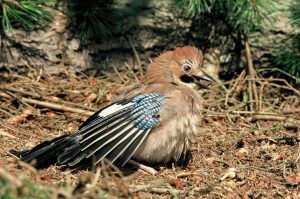Highland Wildlife Diary for July 2013
Our monthly columnist from the Scottish Highlands
A long-time associate of Vine House Farm is Roger Hughes, who now lives in the north of Scotland and the beautiful county of Sutherland. Roger helps us with a range of business services, but he’s also a keen bird watcher, is very knowledgeable about feeding birds, is a general nature lover, and also partly earns his living from writing. He lives with his wife, Julie, and they have a small croft with a wide mix of habitats from wooded riverbank to meadow and moorland – all good for wildlife of course. So with all this in mind, Roger now writes a monthly column for the Vine House Farm website which we very much hope you’ll follow and enjoy.
North Highland wildlife diary – July
In last month’s column I promised I’d spend some time watching wildlife on the coast, so I’ve done just that with two trips out – both of which were productive.
Our nearest seaside village is Golspie, which is about 10 miles from our home. I often park there and walk along the beach, which stretches for some 4 miles to a tiny hamlet called Little Ferry. It isn’t perhaps the most picturesque length of coastline in the Highlands, but it is relatively quiet and peaceful, and, once you’re a half a mile or so away from the village and therefore out of range of most dog walkers, you pretty-much have the beach to yourself. In fact my record is to walk the entire 4 miles and only see one other person – and that was also in July.
There’s usually plenty to see, with Moray Firth’s Bottlenose Dolphins occasionally swimming close to the shore, and, more typically, the bobbing heads of Grey Seals keeping a watchful eye on the unfamiliar sight of a walker and occasional dog. But arriving at the beach last week I had a special treat, and was literally taking my telescope out of the car when I first spotted it some 50 metres from the shoreline and easily visible from the car park: a Black-throated Diver. And the photo above is of the very same bird, though with just a 300mm lens on my camera that was the closest I could get.
I watched the bird for some 30 minutes, though for most of the time it was just relaxing and was fairly inactive in the very warm July sun (and, yes, we’ve also had a heat wave up here...). It occasionally took time to preen its exquisite plumage – and ‘exquisite’ hardly begins to describe the plumage of the Black-throated Diver – but other than that it obligingly kept still for me to snap photos of it.
I continued my walk up the beach and then noticed a group of about twelve birds on the water and perhaps 150 metres from the shore. A quick look with the telescope revealed... they were also Black-throated Divers! So this was by far the most of this iconic north-west Highland species I’d ever seen at once, and although I knew they often headed for the inner Moray Firth after breeding, I was little surprised to see them so early in mid-July. So I’ll need to research that a little more, though I do know that they’ve been enjoying an increase in breeding numbers and this largely down to an RSPB initiative to build floating rafts for them in the Sutherland lochs where they breed, and this aimed at overcoming the problem of their usual loch-side nests becoming submerged when water levels rise after heavy rain.
My other trip to the coast was to the far north and a lovely little harbour called Dwarwick which is close to Dunnet Head in Caithness. In truth the trip was with a friend for fishing as much as it was bird watching, though I’ve always combined the two interests and, indeed, it was fishing with my dad on the lakes in Hampton Court Royal Park when I was a child which first got me interested in birds! (There can be a LOT of time to watch birds when you’re out fishing but catching nout.) Anyway, there were plenty of seabirds to watch with the most notable being a few Great Skuas which passed just overhead and with their usual purposeful flight in the hunt of other seabirds to terrorise – including Gannets which are a far larger bird – in order to make them drop their catch.
And did we catch anything? We did indeed, with my friend catching five Dogfish – which are a small species of shark – and me catching one plus a Flounder. The Dogfish were of course all returned safe and well to the sea, though the Flounder came home with me and made a very tasty lunch the very next day.
A long-time associate of Vine House Farm is Roger Hughes, who now lives in the north of Scotland and the beautiful county of Sutherland. Roger helps us with a range of business services, but he’s also a keen bird watcher, is very knowledgeable about feeding birds, is a general nature lover, and also partly earns his living from writing. He lives with his wife, Julie, and they have a small croft with a wide mix of habitats from wooded riverbank to meadow and moorland – all good for wildlife of course. So with all this in mind, Roger now writes a monthly column for the Vine House Farm website which we very much hope you’ll follow and enjoy.
North Highland wildlife diary – July
In last month’s column I promised I’d spend some time watching wildlife on the coast, so I’ve done just that with two trips out – both of which were productive.
Our nearest seaside village is Golspie, which is about 10 miles from our home. I often park there and walk along the beach, which stretches for some 4 miles to a tiny hamlet called Little Ferry. It isn’t perhaps the most picturesque length of coastline in the Highlands, but it is relatively quiet and peaceful, and, once you’re a half a mile or so away from the village and therefore out of range of most dog walkers, you pretty-much have the beach to yourself. In fact my record is to walk the entire 4 miles and only see one other person – and that was also in July.
There’s usually plenty to see, with Moray Firth’s Bottlenose Dolphins occasionally swimming close to the shore, and, more typically, the bobbing heads of Grey Seals keeping a watchful eye on the unfamiliar sight of a walker and occasional dog. But arriving at the beach last week I had a special treat, and was literally taking my telescope out of the car when I first spotted it some 50 metres from the shoreline and easily visible from the car park: a Black-throated Diver. And the photo above is of the very same bird, though with just a 300mm lens on my camera that was the closest I could get.
I watched the bird for some 30 minutes, though for most of the time it was just relaxing and was fairly inactive in the very warm July sun (and, yes, we’ve also had a heat wave up here...). It occasionally took time to preen its exquisite plumage – and ‘exquisite’ hardly begins to describe the plumage of the Black-throated Diver – but other than that it obligingly kept still for me to snap photos of it.
I continued my walk up the beach and then noticed a group of about twelve birds on the water and perhaps 150 metres from the shore. A quick look with the telescope revealed... they were also Black-throated Divers! So this was by far the most of this iconic north-west Highland species I’d ever seen at once, and although I knew they often headed for the inner Moray Firth after breeding, I was little surprised to see them so early in mid-July. So I’ll need to research that a little more, though I do know that they’ve been enjoying an increase in breeding numbers and this largely down to an RSPB initiative to build floating rafts for them in the Sutherland lochs where they breed, and this aimed at overcoming the problem of their usual loch-side nests becoming submerged when water levels rise after heavy rain.
My other trip to the coast was to the far north and a lovely little harbour called Dwarwick which is close to Dunnet Head in Caithness. In truth the trip was with a friend for fishing as much as it was bird watching, though I’ve always combined the two interests and, indeed, it was fishing with my dad on the lakes in Hampton Court Royal Park when I was a child which first got me interested in birds! (There can be a LOT of time to watch birds when you’re out fishing but catching nout.) Anyway, there were plenty of seabirds to watch with the most notable being a few Great Skuas which passed just overhead and with their usual purposeful flight in the hunt of other seabirds to terrorise – including Gannets which are a far larger bird – in order to make them drop their catch.
And did we catch anything? We did indeed, with my friend catching five Dogfish – which are a small species of shark – and me catching one plus a Flounder. The Dogfish were of course all returned safe and well to the sea, though the Flounder came home with me and made a very tasty lunch the very next day.


